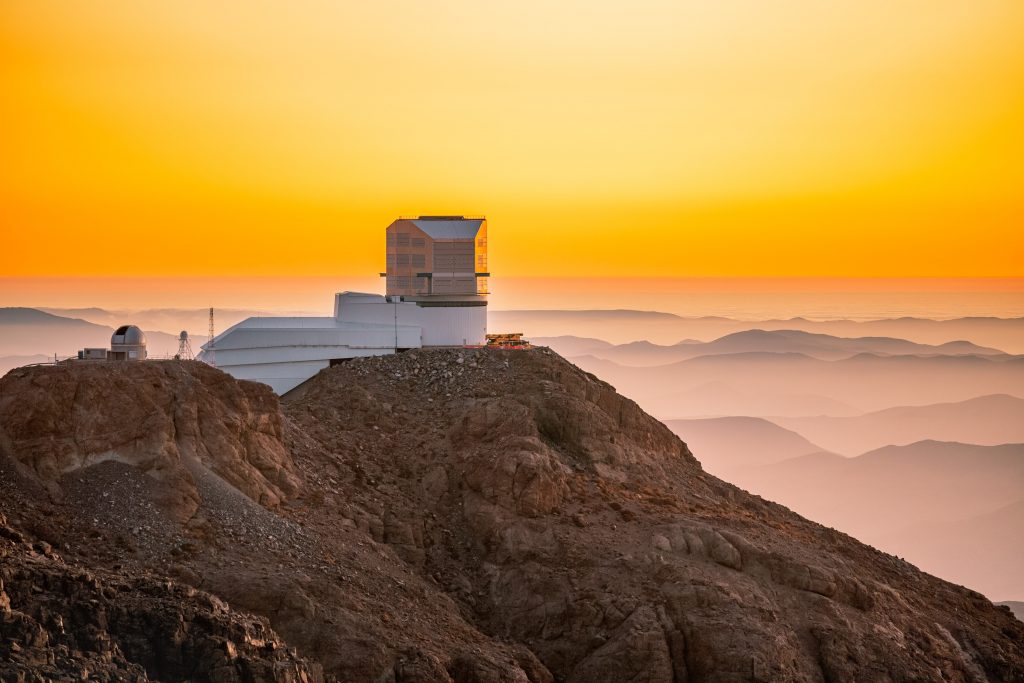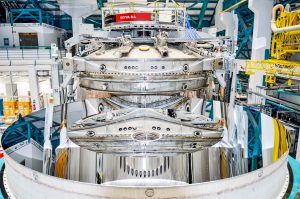
Sunset at Rubin Observatory on Cerro Pachón in Chile. Credit: RubinObs/NOIRLab/SLAC/NSF/DOE/AURA/P. Horálek
The Camera and Observatory
The NSF–DOE Vera C. Rubin Observatory will revolutionize how we understand our night sky and beyond. After the world’s largest camera was completed in April 2024, carefully transported to Cerro Pachón in Chile, and positioned on the 8.4-meter Simonyi Survey Telescope this March, the Rubin Observatory is ready to share its first look at the sky.
The Rubin Observatory was named after Dr. Vera C. Rubin, a pioneering astronomer whose lifelong passion for astronomy motivated her to overcome numerous challenges as a woman working in a field defined by men’s participation.
Dr. Rubin’s most significant scientific contribution was her groundbreaking work on dark matter. She and her colleague, Kent Ford, discovered that stars at the edge of galaxies were moving too fast to be explained by the amount of visible matter in the galaxy alone. This phenomenon was the first convincing evidence of dark matter contributing to the mass of galaxies that we can’t observe directly.
Throughout her career, Dr. Rubin was a strong advocate for women in science. She worked hard to support and mentor young women in astronomy, breaking down barriers and encouraging them to pursue their dreams despite gender inequality and discrimination in academia.
Canada’s participation in the Rubin Observatory
The Rubin Observatory is a US-Chile collaboration, and as such, all members of the Chilean and US academic communities have ‘data rights’ to access observations from the telescope. In 2019, Rubin began a process of ‘International in-kind contributions’ where international partner nations could contribute computational resources, telescope observing time and personnel directly to supporting the scientific infrastructure of the Rubin community, in exchange for the rights to Rubin data.
Canada has secured data rights for Canadian researchers and students through several partnerships, and is building the infrastructure to access and use those data for science. The National Research Council has contributed a data archive and storage facility, while the University of Waterloo and the Dunlap Institute for Astronomy and Astrophysics at the University of Toronto have contributed infrastructure personnel, as well as a successful proposal to the Canadian Foundation for Innovation to build the Canadian Data-Intensive Astrophysics PLatform (CanDIAPL).
“First-Look” images from Rubin

Rubin Observatory’s 8.4-meter combined primary/tertiary mirror was coated with protected silver in April 2024. The reflective coating was applied using the observatory’s onsite coating chamber, which will also be used to re-coat the mirror as necessary during Rubin’s 10-year Legacy Survey of Space and Time. Credit: Rubin Observatory/NSF/AURA
The images released on June 23 will be the first images released from the Rubin Observatory and will signal the start of the 10-year Legacy Survey of Space and Time (LSST), which will create an ultra-wide, ultra-high-definition time-lapsed sky map of the Universe. The survey will be used by astronomers and astrophysicists across the world to study billions of stars, galaxies, and solar system objects—each photographed over 800 times by the Rubin Observatory.
Rubin will scan the entire sky visible from the Cerro Pachon every few nights. These images can be “added” to build a deep picture of galaxies, but can also be “subtracted” to build up a time-lapse to enable discoveries of things that are changing in our sky. The sensitivity of Rubin will be unparalleled: each night the observatory will detect 10 thousand new objects in the sky every night. It will send out 10 million “alerts” that something bright is in the sky to astronomers all over the world, alerting them to possible never-before-seen transients in our ever-changing universe. Moreover, after just one year of operations, astronomers will discover more asteroids than with all previous telescopes combined.
Local experts dive into the Rubin data
Several astronomers at the University of Toronto have been preparing for data from Rubin and are eager to get their hands on this exquisite data. Professor Maria Drout, winner of the 2024 Newton Lacy Pierce Prize in Astronomy from the American Astronomical Society, will use the rapid cadence observations of the night sky that Rubin will provide to study cosmic transients and stellar explosions. She works with Canadian Rubin Fellow Tobias Géron to build pipelines for this data within the Rubin Transient and Variable Stars (TVS) collaboration.
Prof Renée Hlozek will use the supernova sample from Rubin to study dark energy and its evolution across cosmic time, and leads one of the largest science collaborations within the Rubin community, the Dark Energy Science Collaboration. Hlozek, the 2024 recipient of the Rutherford Memorial Medal from the Royal Society of Canada, will be working with Faculty of Arts and Science Fellow Dr. Tanveer Karim, who will use Lyman-Break Galaxies to study the evolution of physical models from the infancy of the Universe.

Vera Rubin operated the 0.9-meter telescope at Kitt Peak National Observatory. Credit: Carnegie Institution for Science
Rubin will also discover some of the most distant RR Lyrae stars in the Milky Way — Professor Gwendolyn Eadie will use these unique stars to study the outer stellar halo of our Galaxy. Prof Eadie, the recipient of the 2024 Dorothy Shoichet Women Faculty in Science Award of Excellence, is jointly appointed between the Astronomy and Statistics departments at UofT and will apply her advanced statistical tools to the Rubin data. She is also working with Postdoctoral Fellow and incoming Schmidt AI in Science Postdoctoral Fellow Kevin McKinnon, who will be using Rubin data in combination with Gaia data to estimate preliminary motions of stars in the outer reaches of the Milky Way.
Also a 2023 recipient of the Dorothy Shoicet award, Professor Ting Li will use Rubin’s deep photometry data to search for dwarf galaxies and stellar streams in the Milky Way halo and the nearby universe, and study the star formation history of the dwarf galaxies and merging history of the Milky Way. Prof Li was recently awarded the 2024 Outstanding Young Researcher Award (OYRA Ardentec Prize) and will be pursuing some of this work with graduate student Nasser Mohammed.
Professor Bob Abraham and 2022 Polanyi Prize winner Prof Josh Speagle will use the images from Rubin to investigate how galaxies evolve over time and, building on their expertise with other telescope collaborations such as the Dark Energy Spectroscopic Instrument (DESI) and the Dragonfly telephoto array, will use them to better understand the nature of dark matter and dark energy.
Speagle will work alongside Dunlap fellows Dr. Mike Walmsley and Dr. Biprateep Dey, who is jointly appointed as a Schmidt AI in Science and also a Canadian Institute for Theoretical Astrophysics fellow, as well as Dr. Kareem, on applying AI methods to understand stars and galaxies, including those found by Rubin. Walmsley is sharing Rubin images with the public on the Zooniverse platform, where volunteers can become citizen scientists and help search for rare galaxies and help calibrate new AI models. Speagle is also a member of Rubin’s Informatics and Statistics Science Collaboration (ISSC).
Open Data for research and teaching
Professor Michael Reid, a teaching-stream faculty member who is always looking to innovate teaching methods in astronomy. Prof. Reid has led the design of some of the large astronomy classes at U of T targeted at non-majors that attract students from many disciplines. He’ll use the many resources produced by the Rubin team to provide opportunities for undergraduate students to get involved in cutting-edge research. This is enabled by the extensive materials that the Rubin Education and Public Outreach team have made available. Rubin data will enable our students to use our University of Toronto telescopes to follow up on transient phenomena in real time.
First Look Watch Party
On Monday, June 23 at 10:30am, the Dunlap Institute will be hosting a Rubin First Look Watch Party. It will take place in Cody Hall (room 107) of the Astronomy & Astrophysics building at 50 St. George street, Toronto. Members of the Rubin collaboration will be present to talk about their research and to answer questions about the new observatory.
About the Dunlap Institute for Astronomy & Astrophysics
The Dunlap Institute for Astronomy & Astrophysics in the Faculty of Arts & Science at the University of Toronto is an endowed research institute with over 80 faculty, postdocs, students, and staff, dedicated to innovative technology, groundbreaking research, world-class training, and public engagement.
The research themes of its faculty and Dunlap Fellows span the Universe and include optical, infrared and radio instrumentation, Dark Energy, large-scale structure, the Cosmic Microwave Background, the interstellar medium, galaxy evolution, cosmic magnetism and time-domain science.
The Dunlap Institute, the David A. Dunlap Department of Astronomy & Astrophysics, and other researchers across the University of Toronto’s three campuses together comprise the leading concentration of astronomers in Canada, at the leading research university in the country.
###
For more information, contact:
Ilana MacDonald
Public Outreach, Communications, and Events Strategist
Dunlap Institute, University of Toronto
media@dunlap.utoronto.ca
